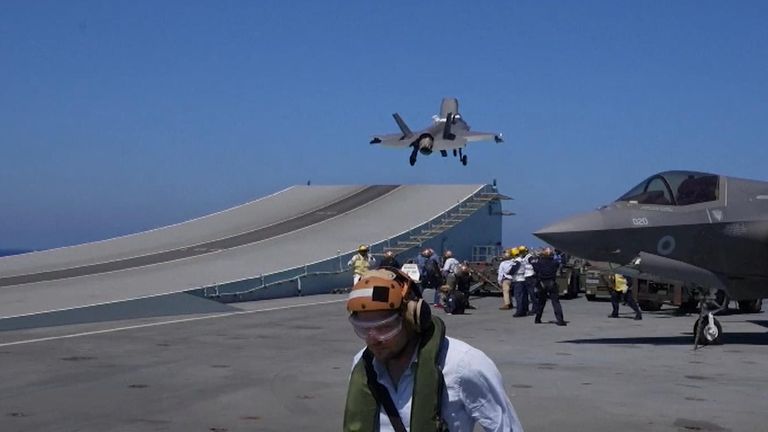Just before midnight on 21 January, four RAF Typhoons attacked a series of Houthi targets in a coordinated wave of UK-US strikes.
It was the eighth attack on the Iran-backed militia by the US, and the second by the RAF, since the first on 11 January.
The latest US strikes were all carried out by jets from the USS Eisenhower.
So why is the UK using land-based RAF Typhoons flying over 3,000-mile missions rather than the immensely capable carrier strike (CS) capability?
By way of background, in early 1997 the Labour government launched a defence review, which sought to build on the global power-projection role developed by Joint Force Harrier.
It led to the commissioning of two Queen Elizabeth-class aircraft carriers to act as the foundations of a new, potent CS group.
They were built at Rosyth dockyard – in Gordon Brown’s then constituency – and entered into service in 2017 and 2019 respectively at a cost of £6bn for the pair.
These are now the most powerful ships in the navy’s history and were designed to deploy with up to 72 strike aircraft on board.
However, unlike the UK nuclear deterrent, which has four Vanguard-class submarines to maintain a “continuous at-sea deterrent”, two carriers were not sufficient to maintain any single carrier at continuous readiness for operational duty.
Unlike the US carrier fleet, which maintains an operational posture around the world 24/7 – each bristling with fighter jets and ready to deploy at very short notice, UK carriers do not routinely have jets on board and often require considerable notice to work up to operational readiness.
‘Missed opportunity’ to show potential
When the US and UK forces attacked the Houthis, the two navy carriers were moored up at Portsmouth.
Why? Aircraft carriers do not operate autonomously.
They routinely deploy with two frigates and two destroyers to provide protection from the air, a submarine, and Royal Fleet Auxiliary (RFA) support ships to replenish fuel and dry stores.
However, the RFA Fort Victoria is the only dry store vessel in service and has limited availability due to a staffing crisis and serviceability.
Its replacements are not due to enter service for several years.
In short, although the UK carrier strike has immense potential, it is not a 24/7 capability and has not been resourced effectively.
The irony is that the UK CS has never deployed a combat mission from its decks since it was commissioned in 2017.
Yet the first occasion when it might have demonstrated its potential [against the Houthis], it was not available.
This conundrum is not lost on the Ministry of Defence.
Indeed, as recently as February 2023, politicians have called for the second of the carriers – HMS Prince of Wales – to be either decommissioned and put in the reserve fleet or to be scrapped or sold.
But even if the UK CS capability had been available, would it have been used?
The Houthis are apparently becoming increasingly effective at targeting merchant and military shipping – bear witness to the excellent performance of HMS Diamond in providing protection to shipping in the region.
Would the UK have risked deploying the carrier and all its support vessels into such a dangerous part of the world?
Although such a deployment would have reduced the distance for the fighters to reach their target, the RAF has the resources and capability to launch such missions from a distance, and at significantly reduced risk.
For low-tempo, precision strikes, the option to launch RAF assets from a main operating base in Cyprus carries significant benefits.
Having flown fighters from the decks of an aircraft carrier, I understand well the enormous potential of carrier-based aviation to have global reach.
However, in these uncertain times, the UK needs assets available at short notice, to deliver decisive effect, and provide swift and comprehensive options to our political masters.
Having a carrier strike capability that is available “some of the time” is just not cost effective.
It is like resourcing a fire brigade that is available only part of the year – with the significant risk that the one time they are needed, they are not available.
Read more from Sky News:
Crew ‘in lifeboats’ as tanker catches fire after Houthi attack
What firepower do UK and US have in the Gulf?
Click to subscribe to the Sky News Daily wherever you get your podcasts
According to Defence Secretary Grant Shapps, we live in an increasingly dangerous world.
When asked if we should increase defence spending as a proportion of GDP to levels seen under Mrs Thatcher (4%), he pointed out it was not just the amount of money spent, but how it’s spent.
Perhaps the UK carrier strike capability provides a cautionary tale for future defence spending.







